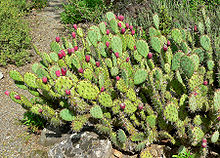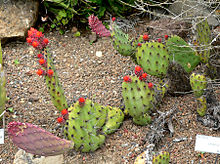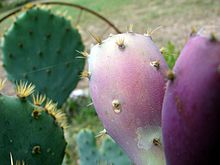仙人掌属
此条目可参照德语维基百科相应条目来扩充,此条目在对应语言版为高品质条目。 (2016年12月) |
| 仙人掌属 | |
|---|---|

| |
| 海滨仙人掌(Opuntia littoralis var. vaseyi) | |
| 科学分类 | |
| 界: | 植物界 Plantae |
| 演化支: | 维管植物 Tracheophyta |
| 演化支: | 被子植物 Angiosperms |
| 演化支: | 真双子叶植物 Eudicots |
| 目: | 石竹目 Caryophyllales |
| 科: | 仙人掌科 Cactaceae |
| 亚科: | 圆扇仙人掌亚科 Opuntioideae |
| 属: | 仙人掌属 Opuntia Mill., 1754 |
| 种 | |
|
参见正文 | |
| 异名 | |
参见正文 | |
仙人掌属(学名:Opuntia),目前分类只包括约200种。[1]圆柱状仙人掌被单独分为一个圆柱仙人掌属(Cylindropuntiais),其他圆筒状仙人掌如以前分在Austrocylindropuntia属、Corynopuntia属和Micropuntia中的种类都包括在本属中。
仙人掌属植物一般具有扁平的绿色叶状茎,来完成光合作用,叶退化成刺,有两种,一种大刺和另一种小刺毛,果实为浆果,可以食用,作为水果,许多种类的叶状茎也可以作为蔬菜食用。仙人掌属植物多数生长在美洲,只有少数品种生长在其他热带地区。
名称
[编辑]学名 Opuntia,来自希腊语的通用名称 Ὀποῦς(Opoûs),指生长在希腊奥普斯城周围的一些植物。[2]
描述
[编辑]典型物种
[编辑]模式种为梨果仙人掌(Opuntia ficus-indica),其有可食用的果实,仙人掌果或叫刺梨,在墨西哥、危地马拉、洪都拉斯、萨尔瓦多、智利、阿根廷、秘鲁、西西里岛、意大利南部、加那利群岛、安达卢西亚、埃斯特雷马杜拉、卡斯蒂利亚南部和西班牙莱万特,用其水果制成果汁、糖果甚至啤酒等产品。它也存在于北非大部分地区和撒哈拉沙漠的野外,尽管它的受欢迎程度和使用情况不同,在某些地区甚至不存在。
分类
[编辑]当卡尔·林奈于1753年出版《植物种志》(现代植物命名法的起点)时,他将他已知的所有仙人掌物种归为一个属 Cactus。1754年,苏格兰植物学家菲利普·米勒将它们分为几个属,其中包括 Opuntia,他主要根据其花和果实的形态来区分属。[3]
仙人掌属 Opuntia 内的物种经常会有相当大的变化。当分类学家从单个标本中描述新物种导致为物种内的变体或生物型创建名称时,分类学混乱就开始了。这个问题在 Opuntia 中尤为明显,现在正在应用DNA测序来解决这个问题。[4]
主要物种
[编辑]












- Opuntia abjecta Small ex Britton & Rose, 1923[5]
- Opuntia aciculata — Chenille prickly pear, old man's whiskers, cowboy's red whiskers
- Opuntia alta
- Opuntia ammophila
- Opuntia anacantha
- Opuntia anahuacensis
- Opuntia arenaria — dune prickly pear;
- Opuntia articulata
- Opuntia atrispina
- Opuntia auberi
- Opuntia aurantiaca
- Opuntia aurea
- Opuntia aureispina
- Opuntia austrina Small, 1903[5]
- Opuntia azurea
- Opuntia basilaris — beavertail cactus;
- Opuntia bentonii
- Opuntia blakeana
- Opuntia boldinghii
- Opuntia cacanapa - including Opuntia ellisiana (Ellisiana)
- Opuntia camanchica - plains prickly pear
- Opuntia canada
- Opuntia cespitosa Rafinesque, 1830[5]
- Opuntia charlestonensis
- Opuntia chaffeyi
- Opuntia chlorotica — pancake prickly pear; native to southwest USA and the Sonoran and Mojave deserts;
- Opuntia chisosensis
- Opuntia clavata
- 胭脂掌 Opuntia cochenillifera
- Opuntia comonduensis
- Opuntia columbiana
- Opuntia confusa
- Opuntia covillei
- Opuntia curvospina
- Opuntia cyclodes
- Opuntia cymochila — grassland prickly pear; One of the most common species found on the Great Plains of the United States
- Opuntia debreczyi
- Opuntia decumana
- Opuntia decumbens — nopal de culebra
- Opuntia dejecta
- 仙人掌 Opuntia dillenii
- Opuntia diploursina — found around Grand Canyon and Lake Mead National Recreation Area; ; resembles O. trichophora
- Opuntia discata
- Opuntia dulcis - 异名:O. phaeacantha major
- Opuntia echinocarpa - 参见 Cylindropuntia echinocarpa
- Opuntia echios
- Opuntia echios var. gigantea – Galápagos prickly pear, Galápagos Islands
- Opuntia elata
- Opuntia elatior Mill. – syn. O. bergeriana
- Opuntia engelmannii — Engelmann's prickly pear, cow's-tongue prickly pear, desert prickly pear, discus prickly pear, Texas prickly pear, calico cactus;
- Opuntia erinacea
- Opuntia exaltata
- Opuntia excelsa
- Opuntia fortanelli Reyes-Agüero, Orta & Heindorf, 2024[6]
- Opuntia ficus-barbarica
- 梨果仙人掌 Opuntia ficus-indica — Indian fig opuntia
- Opuntia fragilis — little prickly pear, brittle cactus, found in the Great Plains and as far west as British Columbia]
- Opuntia galapageia
- Opuntia gosseliniana — violet prickly pear
- Opuntia gosseliniana var. santa-rita – Santa Rita prickly pear
- Opuntia chlorotica var. gosseliniana
- Opuntia helleri K.Schum. ex B.L.Rob., 1902,为Opuntia galapageia' var. helleri (K.Schum. ex B.L.Rob.) Backeb.的异名
- Opuntia hickenii Britton & Rose, 1919,为Maihueniopsis hickenii (Britton & Rose) D.R.Hunt的异名
- 匍地仙人掌 Opuntia humifusa (Raf.) Rafinesque, 1830 — eastern prickly pear (有时也包括O. compressa);[7][5]
- Opuntia hyptiacantha
- Opuntia inamoema K. Schum. – quipá
- Opuntia insularis
- Opuntia invicta ,异名: Corynopuntia invicta, Grusonia invicta
- Opuntia jamaicensis
- Opuntia laevis
- Opuntia lasiacantha
- Opuntia leucotricha — arborescent prickly pear, Aaron's beard cactus, semaphore cactus, Duraznillo blanco, nopal blanco
- Opuntia lindheimeri — cowtongue prickly pear
- Opuntia littoralis — coastal prickly pear, sprawling prickly pear
- Opuntia longispina
- Opuntia macrocentra — black-spined prickly pear, purple prickly pear, found in southwest USA and northern Mexico
- Opuntia macrorhiza — Plains prickly pear, found throughout the Great Plains except for the northernmost areas (not found in North Dakota), and extending sporadically eastward as far as Kentucky, syn. O. leptocarpa MacKensen, O. tenuispina Engelm., O. tortispina Engelm. & Bigelow; [5]
- Opuntia matudae — xoconostle (异名: Opuntia joconostle)
- Opuntia maldonandensis
- Opuntia maxima
- Opuntia megacantha
- Opuntia megarrhiza
- Opuntia megasperma
- Opuntia mesacantha Rafinesque, 1830[5]
- 黄毛仙人掌 Opuntia microdasys — bunny ears cactus, polka-dot cactus
- 单刺仙人掌 Opuntia monacantha — common prickly pear
- Opuntia nichollii - Distributed throughout much of the Colorado Plateau, from Grand Canyon north to Price, Utah and east to the Colorado border;
- Opuntia nemoralis Griffiths, 1913[5]
- Opuntia ochrocentra Small ex Britton & Rose, 1923[5]
- Opuntia oricola
- Opuntia ovata
- Opuntia pachyrrhiza
- Opuntia pailana
- Opuntia paraguayensis
- Opuntia phaeacantha — tulip prickly pear, includes plateau prickly pear, brown-spined prickly pear, Mojave prickly pear, Kingman prickly pear;
- Opuntia picardoi
- Opuntia pinkavae — Pinkava's prickly pear;
- Opuntia polyacantha — Panhandle prickly pear, found in the Great Plains, Great Basin, Mojave Desert, Colorado Plateau, and the Rocky Mountains, 异名:O. rhodantha K.Schum.;
- Opuntia polyacantha var. arenaria (异名:O. erinacea)
- Opuntia pubescens (异名:O. pascoensis Britton & Rose)
- Opuntia pusilla — creeping cactus, 异名:O. drummondii Graham
- Opuntia quitensis — Red Buttons opuntia (异名: O. macbridei, O. johnsonii, Platyopuntia quitensis)
- Opuntia rastrera
- Opuntia repens
- Opuntia robusta
- Opuntia rufida (有时包括O. microdasys)
- Opuntia saxicola
- Opuntia schumannii
- Opuntia soehrensii
- Opuntia stenopetala (异名:O. riviereana Backeb.)
- Opuntia streptacantha
- 缩刺仙人掌 Opuntia stricta — erect prickly pear, spineless prickly pear
- Opuntia sulphurea
- Opuntia taylori
- Opuntia tehuantepecana — nopal de caballo
- Opuntia tomentosa — woollyjoint prickly pear
- Opuntia triacantha
- Opuntia trichophora
- Opuntia tuna
- Opuntia velutina
- Opuntia violacea
被另外分列的属
[编辑]以前曾被列在仙人掌属中,现在单独分列的属:
- Austrocylindropuntia
- Brasiliopuntia
- Corynopuntia
- Cylindropuntia
- Disocactus phyllanthoides (as Opuntia speciosa)
- Micropuntia
- Miqueliopuntia
分布与栖息地
[编辑]像大多数仙人掌物种一样,仙人掌属物种只原产于美洲。通过人类的行为,它们已被引入世界许多其他地区。[4][8]在墨西哥,特别是在中部和西部地区以及加勒比群岛(西印度群岛)发现了大量的仙人掌属物种。在美国,仙人掌属原产于中西部和中南部干旱、半干旱和易旱的许多地区,包括落基山脉的低海拔地区和大平原南部,那里的物种如 O. phaeacantha 和 O. polyacantha 占主导地位,并在西南沙漠地区流行,那里有几种类型。仙人掌属物种也原产于从佛罗里达州到康涅狄格州南部的东海岸沙质海岸海滩灌木环境中,从东海岸向南进入加勒比海和巴哈马,发现了 O. humifusa、O. stricta 和 O. pusilla。此外,东部仙人掌原产于中西部“沙草原”附近的主要河流系统,如密西西比河、伊利诺伊河和俄亥俄河。[9]该植物也自然生长在伊利诺伊州南部的丘陵地区,以及伊利诺伊州北部的沙地或岩石地区。[10]
达尔文是第一个注意到这些仙人掌有趋性雄蕊的人。当接触到花药时,它们会蜷缩起来,沉积花粉。通过轻轻戳一朵开放的仙人掌花的雄蕊可以看到这种运动。相同的性状在其他属物种(例如乌羽玉属Lophophora)中趋同演化。
毒性
[编辑]
虽然这些植物是可食用的,但不应食用尖毛,有乳状汁液的类似物中都应小心。[11]
用途
[编辑]| 每100 g(3.5 oz)食物营养值 | |
|---|---|
172 kJ(41 kcal) | |
9.6 g | |
| 膳食纤维 | 3.6 g |
0.5 g | |
0.7 g | |
| 维生素 | |
| 维生素A equiv. | (3%) 25 μg |
| 核黄素(维生素B2) | (8%) 0.1 mg |
| 烟碱酸(维生素B3) | (3%) 0.5 mg |
| 吡哆醇(维生素B6) | (8%) 0.1 mg |
| 叶酸(维生素B9) | (2%) 6 μg |
| 维生素C | (17%) 14.0 mg |
| 维生素E | (0%) 0 mg |
| 膳食矿物质 | |
| 钙 | (6%) 56 mg |
| 铁 | (2%) 0.3 mg |
| 镁 | (24%) 85 mg |
| 磷 | (3%) 24 mg |
| 钾 | (5%) 220 mg |
| 锌 | (1%) 0.1 mg |
| 其他成分 | |
| 水 | 88 g |
| Full Link to USDA Database entry 参照美国标准的相对百分比 成人每日的参考膳食摄入量(DRI) 来源:(英文)美国农业部营养数据库 | |
营养
[编辑]生仙人掌茎含有 88% 的水、10% 的碳水化合物和不到 1% 的蛋白质和脂肪。在100克的参考分量中,可提供170千焦耳的食物热量,17%的维生素C每日摄入量,24% 的镁摄入量,没有其他显着含量的微量营养素。
地区性的食用
[编辑]仙人掌的果实
[编辑]仙人掌的果实,通常称为仙人掌果(西班牙语:Tuna[12])、刺梨(英语:Prickly pears)、仙人掌无花果(cactus fig)、印地安无花果(Indian fig[13],可食用的,但必须在吃之前去掉外皮以去除外皮上的小刺。[14]如果没有正确去除外皮,可能会摄入小刺,小刺很容易卡在皮肤中,导致喉咙、嘴唇和舌头不适。像德贵斯塔这样的美洲原住民会将仙人掌果在合适的介质(例如沙砾)中滚动,磨除小刺。或者,在篝火或火把的火焰中旋转水果已用于去除小刺。仙人掌果的种子可用于面粉。[15]现今,也育有无核的品种。
在墨西哥,仙人掌果常被用来制作开胃菜、汤、沙拉、主菜、蔬菜菜肴、面包、甜点、饮料、糖果、果冻和饮料。[16][17][18]
仙人掌的茎片
[编辑]在大多数仙人掌物种,仙人掌的较嫩的茎片(西班牙语:Nopales)也是可食用的。[16][14] 它们通常用于墨西哥菜中的菜肴中,例如仙人掌茎炒鸡蛋(西班牙语:huevos con nopales)或是仙人掌茎塔可(西班牙语:Racos de nopales)。仙人掌茎也是美国新墨西哥州饮食的重要成分。[16]2009年,它作为一种更便宜的玉米替代品被引入,用于生产玉米饼和其他玉米产品。[19]它们也可以腌制后食用。[15]
民间医学
[编辑]在墨西哥传统医学中,它的仙人掌的果肉和汁液被认为是治疗消化道和泌尿道的伤口和炎症的药物,[20]尽管没有总够证据表明将仙人掌用于这些目的有任何临床益处。
在现代医学之前,美洲原住民和墨西哥人主要使用仙人掌作为开放性伤口的凝固剂,通过撕裂仙人掌茎片或刮取使用茎片上果肉。[21]
在最近的一项研究中,发现仙人掌有助于预防或减缓糖尿病、肥胖症、代谢综合征、心血管疾病和某些癌症的发生。与安慰剂组相比,服用仙人掌的组的结果显示 BMI、身体成分和腰围有所减少。[22]
其他用途
[编辑]在染料生产中
[编辑]
胭脂虫是一种蚧壳虫,原产于热带和亚热带的南美洲和墨西哥,是固着性寄生虫,生活在仙人掌属的植物上,以仙人掌汁液中的水分和营养为食。这种昆虫会产生胭脂红酸,从而阻止其他昆虫的捕食。胭脂红酸可以从昆虫的身体和卵中提取出来,制成红色染料。
胭脂虫红主要用作红色食用色素和化妆品。[16]胭脂虫在前殖民时代,已经做为染料被北美洲]和中美洲的阿兹特克和玛雅人以及南美洲的印加人使用。胭脂虫几乎完全由当原住民生产商在墨西哥瓦哈卡当地生产,成为墨西哥仅次于白银的第二大出口产品。[23]这种染料在整个欧洲都被消费,而且价值很高,伦敦和阿姆斯特丹商品交易所定期报价。
胭脂虫的最大生产国是秘鲁、加那利群岛和智利。当前对人工食品添加剂的健康担忧使胭脂虫染料重新流行起来,需求的增加使胭脂虫养殖成为其他地区(例如墨西哥)的一个有吸引力的机会。由于天敌众多,胭脂虫的产量再次下降。[24]
除胭脂虫红外,红染料甜菜根红素(英语:Betanin)还可以从一些仙人掌植物本身中提取。[16]
动物饲料
[编辑]仙人掌可做为干燥和干旱地区的动物饲料作物。[25]
作为“纯素皮革”的来源
[编辑]仙人掌的厚皮可以做为环保皮革替代动物皮革。[26]
燃料
[编辑]对于生物塑料
[编辑]参考文献
[编辑]- Behan, Jeff (1995): The bug that changed history. Boatman's Quarterly Rreview 8(2). HTML fulltext
- Bwititi, P.; Musabayane, C.T. & Nhachi, C.F.B. (2000): Effects of Opuntia megacantha on blood glucose and kidney function in streptozotocin diabetic rats. Journal of Ethnopharmacology 69(3): 247-252. doi:10.1016/S0378-8741(99)00123-3 PMID 10722207 (HTML abstract)
- Cota-Sánchez, J. Hugo (2002): Taxonomy, distribution, rarity status and uses of Canadian Cacti. Haseltonia 9: 17-25[29] PDF abstract(页面存档备份,存于互联网档案馆)
- Frati-Munari, A.C.; Fernandez-Harp, J.A.; de la Riva, H.; Ariza-Andraca, R. & del Carmen Torres, M. (1983): Effects of nopal (Opuntia sp.) on serum lipids, glycemia and body weight. Archivos de investigacion medica 14(2): 117-125. PMID 6314922 [Article in English, Spanish]
- Ott, Jonathan (1995): Ayahuasca Additive Plants(页面存档备份,存于互联网档案馆). In: Ayahuasca Analogues: Pangaean Entheogens.
- Pittler, Max H.; Verster, Joris C. & Ernst, Edzard (2005): Interventions for preventing or treating alcohol hangover: systematic review of randomised controlled trials. Brit. Med. J. 331(7531): 1515-1518. doi:10.1136/bmj.331.7531.1515 PMID 16373736 PDF fulltext(页面存档备份,存于互联网档案馆)
- Portillo M., Liberato & Vigueras G., Ana Lilia (1988): Natural Enemies of Cochineal (Dactylopius coccus Costa): Importance in Mexico. Journal of the Professional Association for Cactus Development 3: 43-49. PDF fulltext
- Rayburn, Keith M.D.; Martinez, Rey; Escobedo, Miguel; Wright, Fred & Farias, Maria (1998): Glycemic Effects of Various Species of Nopal (Opuntia sp.) in Type 2 Diabetes Mellitus. Texas Journal of Rural Health 16(1): 68-76.
- Trenary, Klaus (1997): Visionary Cactus Guide: Opunita [sic]. Retrieved 2007-OCT-15.
- Wiese, Jeff; McPherson, Steve; Odden, Michelle C. & Shlipak, Michael G. (2004): Effect of Opuntia ficus indica [sic] on Symptoms of the Alcohol Hangover. Arch. Intern. Med. 164(12): 1334-1340. PDF fulltext(页面存档备份,存于互联网档案馆)
注释
[编辑]- ^ Jon P. Rebman, Ph.D., "What has happened to Opuntia?" San Diego Natural History Museum. [2008-09-10]. (原始内容存档于2020-09-22).
- ^ California Plant Names: Latin and Greek Meanings and Derivations. [2022-07-18]. (原始内容存档于2022-03-20).
- ^ Miller, Philip. Opuntia. The Gardener's Dictionary v.2 4th. London: John & James Rivington. 1754 [2014-06-13]. (原始内容存档于2022-07-18).
- ^ 4.0 4.1 Opuntia ficus-indica (prickly pear). CABI. 3 January 2018 [23 May 2018]. (原始内容存档于2020-01-28).
- ^ 5.0 5.1 5.2 5.3 5.4 5.5 5.6 5.7 Lucas C. Majure, Walter S Judd, Pamela S Soltis and Douglas E Soltis. 2017. Taxonomic Revision of the Opuntia humifusa complex (Opuntieae: Cactaceae) of the eastern United States. Phytotaxa. 290(1); 1–65. DOI: 10.11646/phytotaxa.290.1.1
- ^ Juan Antonio Reyes-Agüero, Carolina Orta-Salazar, Claudia Heindorf and Eleazar Carranza González. 2024. Opuntia fortanelli (Cactaceae), A New Species from the Huastec Region of San Luis Potosí, México. Haseltonia. 31 (1), 26-33. DOI: 10.2985/026.031.0104
- ^ 中国仙人掌科一新归化种——匍地仙人掌. 广西植物. [2023-03-16]. (原始内容存档于2023-04-09).
- ^ Majure, Lucas C.; Puente, Raul; Griffith, M. Patrick; Judd, Walter S.; Soltis, Pamela S.; Soltis, Douglas E. Phylogeny of Opuntia s.s. (Cactaceae): Clade delineation, geographic origins, and reticulate evolution. American Journal of Botany. 2012-05-01, 99 (5): 847–864. ISSN 0002-9122. PMID 22539520. doi:10.3732/ajb.1100375 (英语).
- ^ Sand prairie. Illinois Department of Natural Resources. 2020 [23 January 2020].[失效链接]
- ^ Eastern prickly pear, Opuntia humifusa, Cactus family (Cactaceae). Illinois Wildflowers. [23 January 2020]. (原始内容存档于2021-10-29).
- ^ The Complete Guide to Edible Wild Plants. United States Department of the Army. New York: Skyhorse Publishing. 2009: 81 [2022-07-18]. ISBN 978-1-60239-692-0. OCLC 277203364. (原始内容存档于2022-09-22) (美国英语).
- ^ Grigson, Jane. Jane Grigson's Fruit Book. U of Nebraska Press. 2007: 380 [2022-07-18]. ISBN 978-0-8032-5993-5. (原始内容存档于2022-07-18).
- ^ 最初的意思指的美洲原住民,但其种加词“ficus-indica”的意思是印度的无花果。注意真正的无花果在南亚。
- ^ 14.0 14.1 Lyle, Katie Letcher. The Complete Guide to Edible Wild Plants, Mushrooms, Fruits, and Nuts: How to Find, Identify, and Cook Them 2nd. Guilford, CT: FalconGuides. 2010: 168 [2004]. ISBN 978-1-59921-887-8. OCLC 560560606.
- ^ 15.0 15.1 Angier, Bradford. Field Guide to Edible Wild Plants. Harrisburg, PA: Stackpole Books. 1974: 178. ISBN 0-8117-0616-8. OCLC 799792.
- ^ 16.0 16.1 16.2 16.3 16.4 Yvonne Savio. Prickly pear cactus production. Small Farm Center. University of California – Davis. 1989 [23 December 2015]. (原始内容存档于2021-08-15).
- ^ Midey, Connie. A magical plant. The Arizona Republic. May 31, 2005 [May 22, 2010].
- ^ Jarman, Max. Hand crafted hooch: Prickly pear vodka from Flagstaff. The Arizona Republic. October 11, 2005 [May 22, 2010].
- ^ Trevino, Miguel Trancozo. The remarkable power of the prickly pear. www.bbc.com. [2020-06-01]. (原始内容存档于2022-07-18) (英语).
- ^ Frati AC, Xilotl Díaz N, Altamirano P, Ariza R, López-Ledesma R. The effect of two sequential doses of Opuntia streptacantha upon glycemia. Archivos de Investigación Médica. 1991, 22 (3–4): 333–6. PMID 1844121.
- ^ del Socorro Santos Díaz, María; Barba de la Rosa, Ana-Paulina; Héliès-Toussaint, Cécile; Guéraud, Françoise; Nègre-Salvayre, Anne. Opuntia spp.: Characterization and Benefits in Chronic Diseases. Oxidative Medicine and Cellular Longevity. 2017, 2017: 8634249. PMC 5401751
 . PMID 28491239. doi:10.1155/2017/8634249
. PMID 28491239. doi:10.1155/2017/8634249  (英语).
(英语).
- ^ Mayes, V., Lacy, B. B., Ahasteen, J., & Chee, J. (2012). Nanise’: A Navajo herbal: One Hundred Plants from the Navajo Reservation. Chandler, AZ: Five Star Publications, Inc.
- ^ Behan (1995).
- ^ Portillo & Vigueras (1988).
- ^ Lee Allen. Strategic fodder – cactus to the rescue as livestock feed. FarmProgress. January 15, 2016 [25 February 2020]. (原始内容存档于2022-07-18).
- ^ Derya Ozdemir. Creating Leather From Cactus to Save Animals and the Environment. Interesting Engineering. June 23, 2020 [23 June 2020]. (原始内容存档于2022-07-18).
- ^ Ciriminna, Rosaria; Delisi, Riccardo; Albanese, Lorenzo; Meneguzzo, Francesco; Pagliaro, Mario. Opuntia ficus-indica seed oil: Biorefinery and bioeconomy aspects. European Journal of Lipid Science and Technology. 21 February 2017, 119 (8): 1700013. ISSN 1438-7697. doi:10.1002/ejlt.201700013.
- ^ Liz Gyekye. BBC covers biodegradable bioplastics made from cactus juice. BioMarket Insights. June 5, 2019 [February 25, 2020]. (原始内容存档于2020-11-26).
- ^ Google Scholar. [2008-09-10]. (原始内容存档于2017-02-12).




